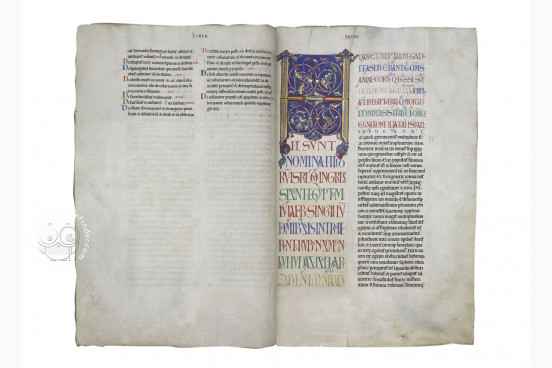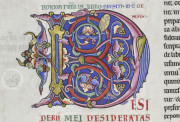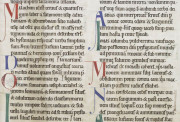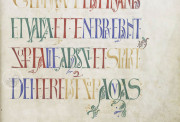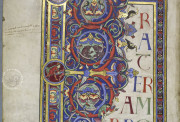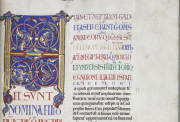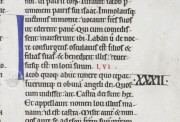The Bury Bible is the surviving volume of a two-volume set of the full biblical text richly illuminated for a monastic house in the middle of the twelfth century. Its large format and expensive, imported materials indicate the great wealth invested in the abbey of Bury St Edmonds through benefactors and pilgrimage. It contains the Old Testament from Genesis through Job. Six full-page illustrations serve as frontispieces to biblical books and the rest begin with partial-page miniatures and historiated and decorated major initials and gilded display text. At least six other illuminated pages were removed.
The bible's artwork was commissioned by the prior's family from an artist named Master Hugh and reflects a strong Byzantine influence in its technique and composition. The brightly colored initials feature fantastic Romanesque beasts inhabiting intertwined Italianate foliage.
The biblical text is written by a single scribe in two columns in a consummate round early Gothic hand with typical abbreviations. It contains several illustrations unique to western manuscripts and bridges the traditions of the Romanesque and Gothic styles.
Although copies of the Bible are not scarce, the wealth of surviving knowledge concerning its patronage, artist, and manufacture in addition to its outstanding beauty make it a most significant manuscript.
Large Luxury Bible for Monastic House
The twelfth century saw the increased popularity of large format luxury bibles created for wealthy monastic foundations. In the case of the Bury Bible, the cost of the commission was covered by Hervey, the brother of the abbey's prior, Talbot. Hervey and Talbot spared no expense in its creation, hiring the best artist available to them, and providing no lack of opulent materials indicated indulgent use of ultramarine and gold.
There are even indications that the illuminations and major decorated initials may have been protected by delicate silk curtains, which have long since fallen away. Such a bible reflects the wealth pouring into Bury due to its increasing role as an important pilgrimage site for the cult of St. Edmund the Martyr.
Master Hugh and the Byzantine Style
Known only by the name Master Hugh, he was a lay artist of great renown and was commissioned at Bury alone to make several artworks in different media such as the bronze doors, a bell, and a choir cross, all lost. His work as an illuminator survives in the Bury Bible's six remaining full-page frontispieces and the dozens of smaller scenes and ornate letters.
According to the colophon, Master Hugh found the quality of local parchment to be poor and so used higher quality parchment from Ireland for the illuminations and pasted them into the pages. His work is defined by a strong Byzantine influence in the green-gray shading on skin tones and the "damp fold" style of drapery. His backgrounds are bold blue and green with gilt ornamented frames and his illuminated letters swirl with Italianate foliage and fantastic Romanesque inhabitants.
Lost Second Volume
The great Bury Bible remained at Bury St Edmunds monastery probably until the Dissolution of the monasteries in the sixteenth century. It retains the abbey's pressmark from the late fourteenth century and both volumes are listed in the register (Douai, Bibl. Munc. 553). It may have been at Oxford suggested by a fragment of its missing second volume found as part of binding material produced there. It came to be owned by Matthew Parker in 1575 and through that ownership came to Corpus Christi College, Cambridge.
Once bound as a single volume, the remaining tome of the Bury Bible was rebound in 1956 into three separate manuscripts. Cased in full blue Morocco, the simple blind-tooled panels have floral accents in the corners both inside and out. This replaced the binding of the 1920s.
We have 1 facsimile edition of the manuscript "Bury Bible": Bury Bible facsimile edition, published by Boydell & Brewer, 2001
Request Info / Price
